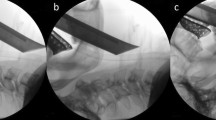Abstract
Considerable forces are exerted on oropharyngeal tissues during microlaryngoscopic procedures. Although it is generally accepted that positioning of the patient’s head influences the quantity of these forces and the easiness of the exposure of the anterior glottis, there is a lack of systematic studies on this topic. The aim of our study was to measure the forces occurring during microlaryngoscopy in different positions. This should result in a recommendation for a “low-pressure” position which minimises the risk of postoperative complications due to tissue trauma. Thirty consecutive patients planned for microlaryngoscopy underwent study procedures. During general anaesthesia, measurements were taken using a tension spring balance in neutral position, during extension of the cervical spine, as well as under moderate and maximum flexion. Elevation of the patient’s head thus flexing the cervical spine reduced the occurring forces significantly. Maximum elevation allowed a full exposure of the anterior commissure in all cases, whereas exposure of the anterior commissure was not possible even with maximum external counterpressure in almost 40% of cases with maximum extended cervical spine. The largest differences were observed between extension, neutral and flexion position, whereas the differences between moderate and maximum flexion were not significant. Elevation of the patient’s head with consecutive flexion of the cervical spine allows for better exposure in microlaryngoscopy and reduces significantly the pressure exerted on the oropharyngeal tissues thus minimising the risk of tissue injury. A slight modification of standard instruments can be necessary when using this “low-pressure” position.




Similar content being viewed by others
References
Condado MA, Morais D, Santos J et al (1994) Hypoglossal nerve paralysis after intubation and direct laryngoscopy. Acta Otorrinolaringol Esp 45:477–479
Drezner DA (1995) Complications of direct laryngoscopy. Otolaryngol Head Neck Surg 112:630–631. doi:10.1016/S0194-5998(95)70232-6
Gugatschka M, Gerstenberger C, Friedrich G (2008) Analysis of forces applied during microlaryngoscopy: a descriptive study. Eur Arch Otorhinolaryngol 265:1083–1087. doi:10.1007/s00405-008-0586-z
Heiden C, Westhues M, Kornmesser HJ (1976) Sideeffects and complications following suspension laryngoscopy (article in Germany). Laryngorhinootologie 55:299–302
Hendrix RA, Ferouz A, Bacon CK (1994) Admission planning and complications of direct laryngoscopy. Otolaryngol Head Neck Surg 110:510–516
Hochman I, Zeitels SM, Heaton JT (1999) Analysis of the forces and position required for direct laryngoscopic exposure of the anterior vocal folds. Ann Otol Rhinol Laryngol 108:715–724
Kleinsasser O (1976) Mikrolaryngoskopie und endolaryngeale Mikrochirurgie. Technik und typische Befunde, 2nd edn. Auflage Schattauer Verlag, Stuttgart
Klussmann JP, Knoedgen R, Damm M, Wittekindt C, Eckel HE (2002) Complications of suspension laryngoscopy. Ann Otol Rhinol Laryngol 111(11):972–976
Müller A, Verges L, Schleier P, Wohlfarth M, Gottschall R (2002) The incidence of microlaryngoscopy associated complications (article in German). HNO 50(12):1057–1061. doi:10.1007/s00106-002-0640-x
Rosen CA, Filho PA, Scheffel L, Buckmire R (2005) Oropharyngeal complications of suspension laryngoscopy: a prospective study. Laryngoscope 115:1681–1684. doi:10.1097/01.MLG.0000175538.89627.0D
Vaughan CW (1993) Vocal fold exposure in phonosurgery. J Voice 7:189–194. doi:10.1016/S0892-1997(05)80350-9
Zeitels SM, Vaughan CW (1994) External counterpressure and internal distension for optimal laryngoscopic exposure of the anterior glottal commissure. Ann Otol Rhinol Laryngol 103:669–675
Author information
Authors and Affiliations
Corresponding author
Rights and permissions
About this article
Cite this article
Friedrich, G., Gugatschka, M. Influence of head positioning on the forces occurring during microlaryngoscopy. Eur Arch Otorhinolaryngol 266, 999–1003 (2009). https://doi.org/10.1007/s00405-009-0913-z
Received:
Accepted:
Published:
Issue Date:
DOI: https://doi.org/10.1007/s00405-009-0913-z




